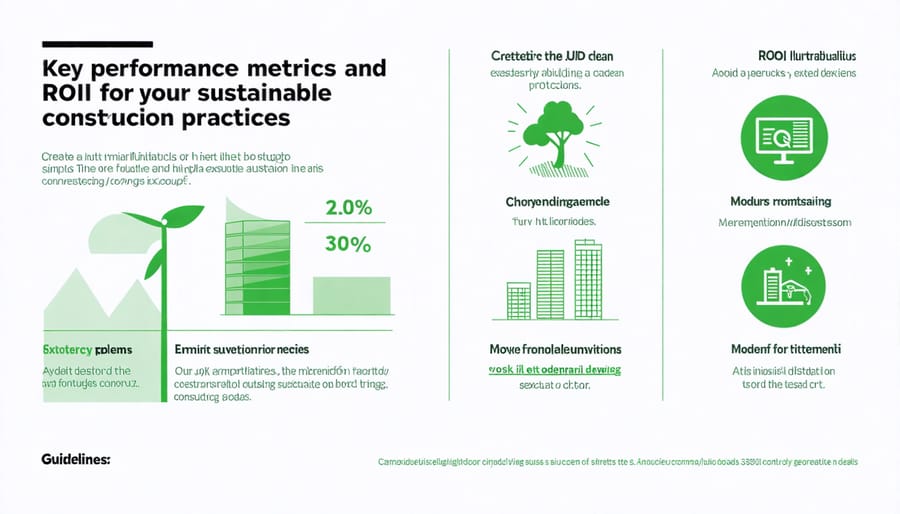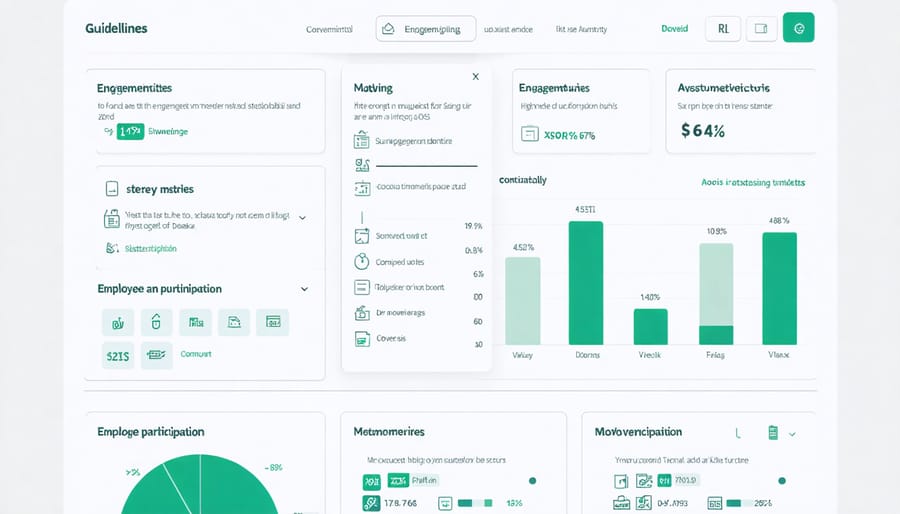Transforming sustainable engagement from buzzword to business reality demands a fundamental shift in how construction firms approach environmental stewardship and employee involvement. Industry leaders who successfully maintain long-term commitment to sustainability initiatives consistently demonstrate three critical elements: measurable impact tracking, embedded organizational values, and clear pathways for employee contribution.
Recent data from leading construction firms reveals that projects with high sustainable engagement scores achieve 23% better resource efficiency and maintain 34% higher employee retention rates. This direct correlation between engagement and operational success isn’t coincidental – it’s the result of strategic integration between sustainability goals and core business operations.
The construction sector stands at a pivotal moment where sustainable engagement has evolved from a nice-to-have initiative to a fundamental business imperative. With increasing regulatory pressure, client demands for green building certifications, and workforce expectations for environmental responsibility, companies must develop robust frameworks that connect individual actions to broader sustainability outcomes.
This comprehensive approach to sustainable engagement doesn’t just drive environmental performance – it creates a competitive advantage by fostering innovation, reducing operational costs, and building stronger relationships with stakeholders across the construction value chain.
The Business Case for Sustainable Engagement
ROI of Long-term Environmental Programs
Recent industry analysis reveals that construction companies implementing long-term environmental programs consistently outperform their counterparts in both financial returns and operational efficiency. Data from the Construction Sustainability Report 2023 shows that firms with established green initiatives achieve 15-20% higher profit margins over a five-year period compared to those without such programs.
These returns manifest through multiple channels, including reduced energy costs (averaging 25% savings), decreased waste management expenses (30% reduction), and enhanced project win rates due to growing demand for sustainable construction. Companies tracking their key performance metrics report that sustainable practices lead to 12% lower material costs and 8% improved labor productivity.
Case studies from leading construction firms demonstrate that initial investments in sustainable programs typically achieve positive ROI within 2-3 years. Notable examples include reduced regulatory compliance costs, enhanced brand value, and improved access to green building certifications. Furthermore, companies with robust environmental programs report 40% lower employee turnover rates, resulting in significant savings in recruitment and training costs.

Employee Retention and Green Leadership
Research consistently shows that companies with robust sustainability programs experience higher employee retention rates, with construction firms being no exception. A recent industry survey revealed that 73% of construction professionals are more likely to remain with employers who demonstrate strong environmental leadership and sustainable practices.
Green leadership initiatives create a sense of purpose beyond traditional project completion metrics. When employees participate in sustainable construction practices, they develop a stronger connection to their work and organization’s mission. This enhanced engagement translates into measurable benefits, including reduced turnover costs and improved project continuity.
Construction companies implementing comprehensive sustainability programs report up to 25% higher retention rates among skilled workers and project managers. Key factors contributing to this success include regular sustainability training, involvement in green building certification processes, and opportunities to contribute to environmental innovation.
To maximize retention through sustainability, industry leaders should:
– Integrate sustainability goals into career development paths
– Recognize and reward environmental achievements
– Provide opportunities for employees to lead green initiatives
– Foster a culture where sustainable practices are valued and celebrated

Building Lasting Environmental Champions
From Interest to Investment
Converting initial employee interest in sustainability into lasting commitment requires a structured approach that aligns with both organizational goals and individual aspirations. Construction companies can achieve this transformation through a three-tiered strategy: education, empowerment, and recognition.
Begin by establishing a comprehensive understanding of sustainable construction practices through targeted training programs. These should cover both theoretical foundations and practical applications, enabling employees to see the direct impact of their work on environmental outcomes. Regular workshops focusing on specific sustainable building techniques, materials, and certifications help maintain momentum and deepen expertise.
Empowerment comes through meaningful involvement in decision-making processes. Create sustainability committees that include representatives from various departments, giving employees a platform to contribute ideas and influence company policies. Assign sustainability champions within project teams who can guide implementation and serve as knowledge resources for their colleagues.
Recognition systems play a crucial role in cementing long-term commitment. Develop metrics that measure both individual and team contributions to sustainability goals. These might include waste reduction achievements, energy efficiency improvements, or innovative sustainable solutions implemented on projects. Celebrate successes through formal awards programs and share case studies of successful initiatives across the organization.
Financial incentives, when aligned with sustainability targets, can further strengthen commitment. Consider incorporating sustainability performance metrics into bonus structures and career advancement opportunities, demonstrating that environmental stewardship is integral to professional growth within the organization.
Measuring and Maintaining Momentum
To effectively track and maintain sustainable engagement, organizations must establish robust measurement systems and regular assessment protocols. Key performance indicators (KPIs) should include both quantitative metrics, such as energy consumption reduction and waste diversion rates, and qualitative measures like employee participation levels and initiative feedback.
Regular sustainability audits, conducted quarterly or bi-annually, help identify areas of success and improvement opportunities. These assessments should evaluate progress against established benchmarks while considering industry standards and best practices. Construction firms can utilize digital dashboards to monitor real-time performance data, enabling quick responses to any engagement dropoffs.
Employee surveys and feedback mechanisms are crucial for understanding engagement levels. Anonymous feedback channels allow team members to voice concerns and suggestions freely, while structured interviews with project leaders provide deeper insights into implementation challenges.
To maintain momentum, organizations should:
– Celebrate milestone achievements publicly
– Implement recognition programs for sustainability champions
– Provide regular training updates and skill development opportunities
– Share success stories across project teams
– Create competitive challenges between departments or sites
– Establish clear accountability structures
Documentation of progress and outcomes helps demonstrate the tangible benefits of sustainable practices, reinforcing long-term commitment. Regular reporting to stakeholders maintains transparency and accountability while encouraging continued support for sustainability initiatives.
Remember that measuring and maintaining momentum requires consistent effort and adaptation of strategies based on collected data and feedback.
Case Study: Sustainable Engagement Success
Turner Construction’s Pacific Northwest division demonstrates how sustainable engagement can transform organizational culture and drive measurable results. In 2019, the company launched its “Green Builder Initiative,” a comprehensive program designed to integrate sustainability practices across all project phases while maintaining high employee involvement.
The program began by establishing cross-functional sustainability teams, comprising project managers, site supervisors, and trade partners. Each team was empowered to identify and implement sustainability improvements within their specific project scope. Key to the program’s success was the creation of a structured feedback loop, where team members could regularly share challenges and innovations through digital platforms and monthly in-person meetings.
Turner implemented several innovative engagement strategies, including:
– A points-based recognition system rewarding sustainable practices
– Quarterly sustainability challenges between project teams
– Regular training sessions on emerging green building technologies
– Partnership programs with local environmental organizations
– Digital dashboard tracking of sustainability metrics and achievements
The results after two years were remarkable. The division reported:
– 32% reduction in construction waste
– 45% increase in recycled material usage
– 28% decrease in energy consumption across project sites
– 89% employee participation rate in sustainability initiatives
– 25% improvement in project LEED certification scores
Perhaps most significantly, employee retention rates improved by 24% among team members actively involved in sustainability programs. Project Manager Sarah Chen notes, “The initiative created a sense of purpose beyond traditional construction goals. Team members felt they were contributing to something larger than themselves.”
The program’s success hinged on three critical factors: clear communication of sustainability objectives, consistent recognition of employee efforts, and tangible measurement of outcomes. Regular sustainability workshops and site visits helped maintain momentum and ensure continuous learning.
Turner’s approach demonstrates that sustainable engagement requires more than just initial enthusiasm – it demands systematic support, measurable goals, and ongoing commitment from leadership. The company continues to refine its program, incorporating feedback and adapting to new environmental challenges while maintaining strong employee participation.
Implementation Framework
Program Structure and Governance
Effective sustainable engagement requires a robust governance framework that aligns with established construction resource management practices. Organizations should establish a dedicated sustainability steering committee comprising key stakeholders from different departments, including project managers, site supervisors, and environmental specialists.
This committee should develop clear lines of accountability, with specific roles and responsibilities assigned to team members at all levels. Regular performance reviews and sustainability audits help maintain program momentum and identify areas for improvement. Implementation of a structured reporting system ensures transparency and facilitates data-driven decision-making.
Key elements of an effective governance structure include:
– Quarterly sustainability performance reviews
– Clear KPIs and metrics for measuring progress
– Regular stakeholder communication channels
– Documented procedures for sustainability initiatives
– Integration with existing quality management systems
– Mechanism for employee feedback and suggestions
To ensure long-term success, organizations should establish a formal change management process that addresses resistance and promotes continuous improvement. This includes regular training programs, recognition systems for sustainability champions, and documented procedures for implementing new initiatives. The governance structure should be flexible enough to adapt to changing regulations and industry best practices while maintaining consistent oversight of sustainability goals.
Technology and Tools
Modern construction companies are increasingly leveraging digital tools to streamline and enhance their sustainability engagement initiatives. Cloud-based project management platforms like Procore and Autodesk Construction Cloud now feature dedicated sustainability tracking modules, enabling real-time monitoring of environmental metrics and team participation rates. These platforms facilitate effective stakeholder engagement through automated reporting and collaborative features.
Mobile applications have become instrumental in field-level engagement tracking, allowing workers to log sustainability actions, report issues, and access training materials directly from their devices. Smart sensors and IoT devices are being deployed to monitor resource usage, waste management, and energy consumption, providing valuable data for engagement analytics and decision-making.
Data visualization tools like Power BI and Tableau help transform complex sustainability metrics into actionable insights, making it easier for project managers to identify trends, measure participation levels, and adjust engagement strategies accordingly. Integration capabilities between these tools and existing construction management systems ensure seamless data flow and reduced administrative burden.
Environmental management systems (EMS) software solutions offer comprehensive frameworks for tracking sustainability goals, compliance requirements, and engagement metrics across multiple projects and teams. These systems often include features for document management, training records, and certification tracking, creating a centralized hub for all sustainability-related activities and engagement initiatives.

The construction industry stands at a pivotal moment in its sustainability journey, where maintaining long-term engagement is crucial for achieving meaningful environmental and social impact. As our analysis has shown, successful sustainable engagement requires a multifaceted approach combining strategic leadership, comprehensive training programs, and measurable accountability systems.
The key to lasting success lies in the integration of sustainability principles into core business operations rather than treating them as separate initiatives. Organizations that have achieved this integration consistently demonstrate higher employee engagement levels, improved project outcomes, and enhanced competitive advantage in the marketplace.
Looking ahead, the construction sector can expect increased pressure to deliver sustainable solutions, driven by stricter regulations, client demands, and global climate commitments. This evolution presents both challenges and opportunities. Companies that invest in developing robust sustainable engagement frameworks today will be better positioned to navigate future requirements and capitalize on emerging opportunities.
To maintain momentum, organizations should focus on continuous improvement of their engagement strategies, regular assessment of outcomes, and adaptation to changing industry needs. The future success of sustainable construction will depend largely on our ability to maintain and enhance engagement across all organizational levels, from site workers to executive leadership.
By embracing these principles and maintaining a committed focus on sustainable engagement, the construction industry can continue its transformation toward a more environmentally responsible and socially conscious future.

